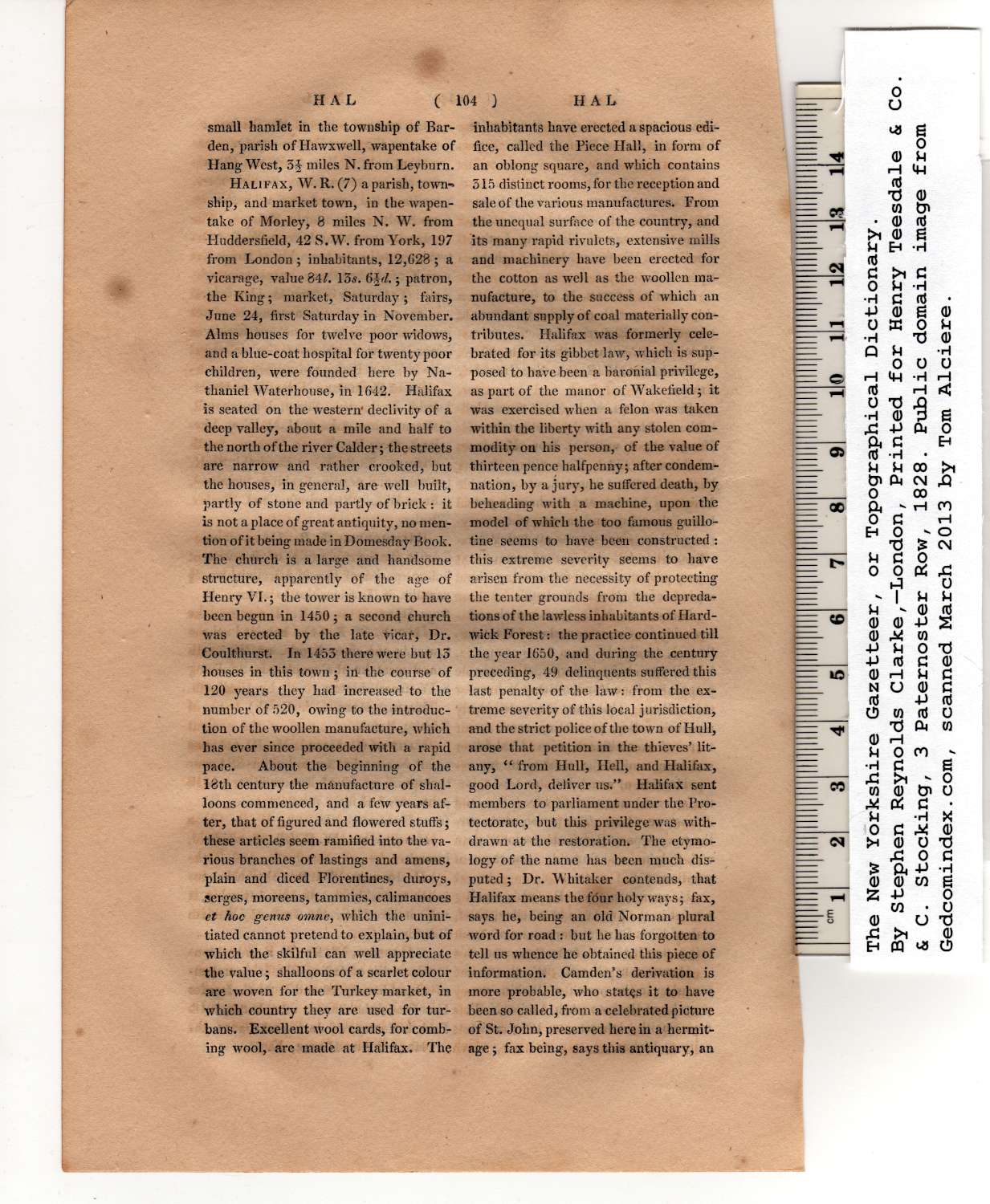|
small hamlet in the township of Bar-
den, parish of Hawxwell, wapentake of
Hang West, 3§ miles N. from Leyburn. |
Halifax, W. R. (7) a parish, town-*
ship, and market town, in the wapen-
take of Morley, 8 miles N. W. from
Huddersfield, 42 S.W. from York, 197
from London; inhabitants, 12,628; a
vicarage, value 84/. 13*. 6§d.; patron,
the King; market, Saturday; fairs,
June 24, first Saturday in November.
Alms houses for twelve poor widows,
and a blue-coat hospital for twenty poor
children, were founded here by Na-
thaniel Waterhouse, in 1642. Halifax
is seated on the western' declivity of a
deep valley, about a mile and half to
the north of the river Calder; the streets
are narrow and rather crooked, but
the houses, in general, are well built,
partly of stone and partly of brick : it
is not a place of great antiquity, no men-
tion of it being made in Domesday Book.
The church is a large and handsome
structure, apparently of the age of
Henry VI.; the tower is known to have
been begun in 1450; a second church
was erected by the late vicar, Dr.
Coulthurst. In 1453 there were but 13
houses in this town; in the course of
120 years they had increased to the
number of 520, owing to the introduc-
tion of the woollen manufacture, which
has ever since proceeded with a rapid
pace. About the beginning of the
18th century the manufacture of shal-
loons commenced, and a few years af-
ter, that of figured and flowered stuffs;
these articles seem ramified into the va-
rious branches of lastings and amens,
plain and diced Florentines, duroys,
serges, moreens, tammies, calimancoes
et hoc genus omne, which the unini-
tiated cannot pretend to explain, but of
which the skilful can well appreciate
the value; shalloons of a scarlet colour
are woven for the Turkey market, in
which country they are used for tur-
bans. Excellent wool cards, for comb-
ing wool, are made at Halifax. The
inhabitants have erected a spacious edi-
fice, called the Piece Hall, in form of
an oblong square, and which contains
315 distinct rooms, for the reception and
sale of the various manufactures. From
the unequal surface of the country, and
its many rapid rivulets, extensive mills
and machinery have been erected for
the cotton as well as the woollen ma-
nufacture, to the success of which an
abundant supply of coal materially con-
tributes. Halifax was formerly cele-
brated for its gibbet law, which is sup-
posed to have been a baronial privilege,
as part of the manor of Wakefield; it
was exercised when a felon was taken
within the liberty with any stolen com-
modity on his person, of the value of
thirteen pence halfpenny; after condem-
nation, by a jury, he suffered death, by
beheading with a machine, upon the
model of which the too famous guillo-
tine seems to have been constructed :
this extreme severity seems to have
arisen from the necessity of protecting
the tenter grounds from the depreda-
tions of the lawless inhabitants of Hard-
wick Forest: the practice continued till
the year 1650, and during the century
preceding, 49 delinquents suffered this
last penalty of the law: from the ex-
treme severity of this local jurisdiction,
and the strict police of the town of Hull,
arose that petition in the thieves’ lit-
any, “ from Hull, Hell, and Halifax,
good Lord, deliver us.” Halifax sent
members to parliament under the Pro-
tectorate, but this privilege was with-
drawn at the restoration. The etymo-
logy of the name has been much dis-
puted ; Dr. Whitaker contends, that
Halifax means the four holy ways; fax,
says he, being an old Norman plural
word for road : but he has forgotten to
tell us whence he obtained this piece of
information. Camden’s derivation is
more probable, who states it to have
been so called, from a celebrated picture
of St. John, preserved here in a hermit-
age ; fax being, says this antiquary, an |
